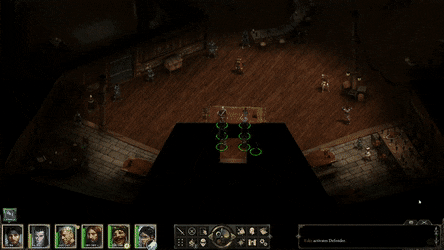Pillars of Eternity - Definitive Edition: Impressions, Criticisms and Review
Published by Obsidian Entertainment. Original release date: March 26th, 2015. Definitive Edition release date: November 15th, 2015.Price: $29.99 MSRP. Current Steam Sale: $7.49. Current Epic Games Sale: $9.99 (with coupon.)
This article has also been published on Tumblr.com (Mirror Link)
12/23/20
Starting with its strengths, Pillars of Eternity is engaging. There is a lot of content to delve into. Much of its characterization is convincing, and the voice acting that it does have is well-performed. Another YouTube channel that I watch, “Should You Play It,” estimated in their review that “25%-30% of the game is voiced,” which seems like an accurate assessment to me. Regarding its story writing, its overall plot and characters themselves are very reminiscent of a decent or good Dungeons and Dragons campaign. Some tropes can be expected, but overall the plot runs smoothly enough, and the characters themselves are generally rather fun to interact with, even in cases where they're not very original.
The game does suffer from a variety of flaws, many of which aren’t immediately apparent to the player and that bear mentioning. The talent pool that Obsidian recruited to do their voices is incredibly small. Half of my party, as it turns out, was voiced by Matthew Mercer--possibly the most distinguished voice actor of the bunch--with my main character (using the “sinister” voice effects), the story character Aloth, and the story character Eder all being voiced by him. Kana, a character that comes later on, is voiced by Patrick Seitz (famous for many different television, video game and anime roles) and also does a character at the beginning of the game (Sparfel), the voice for the commander of the Crucible Knights, and multiple other additional voices. To my own ears, Richard Epcar had to be the most frequently-appearing voice actor in the game, voicing the Caravan Master at the beginning, Raedric’s voice, the spirit of Od Nua (whom I haven’t encountered yet) and the forge master Dunstan in Defiance Bay, along with other additional voices.
Outer Worlds includes a stealing mechanic as well but it was implemented more fairly. Your character didn’t have to dump a bunch of points into a nearly-useless Stealth skill--instead, it was dictated by NPC line-of-sight. Stealing in Outer Worlds, for the most part, is actually *fun*, in Pillars, it was worth me avoiding entirely.
This may as well serve as a segway into the leveling system--on which I don’t have much to say about it, other than (maybe not relative to other ISO-RPGs, or in comparison to, say, Dungeon and Dragons) that it’s a headache. The story characters that the game gives you access to all have unoptimized and relatively-mediocre starting-stats, so to use all of them (exclusively, without hiring an unvoiced “mercenary” NPC) some creative planning is needed. You’ll also effectively want to min-max your own character’s build to help compensate for inevitable party weaknesses--the game (similar to Outer Worlds) offers a releveling system should you level up the wrong stats, but anything set at character creation is basically unchangeable--which is when the greatest number of character traits needs to be decided. Wizards are good, a priest or two is required (otherwise your party is without a healer), Chanters are bad--but you wouldn’t know this unless you looked it up ahead of time, or unless you’ve played the game before.
And this description leads me to my strongest point--Pillars of Eternity has a habit of setting up unclear rules, punishing players for breaking them, and calling that “replayability.” To be clear, if these “unclear rules” were drawn across moral lines then it wouldn’t be an issue. Fallout: New Vegas has a few main factions that the player could side with and give control of the main world to; all but maybe one of these choices could be argued as potentially being the “best outcome.” Pillars of Eternity (and Outer Worlds to a similar extent) is lacking in a lot of this--*and* game mechanic-wise, the game punishes you for doing normal, explorative stuff and so often sets up inconceivably unwinnable scenarios where you have to be so deliberate about your actions and game mechanic options to actually achieve a (clear-cut) best outcome. Outer Worlds is better with this.
A small example; in the beginning of Pillars, your character encounters some rioting townspeople accosting the owner of a grain mill. If you go inside, the mill owner notes that he is fair in his dealings, although he prioritizes the best of his grain stores to townspeople who need it the most (like pregnant women)--this quest being strikingly similar to one in Outer Worlds’s beginning. If you pass a resolve check of 14, the mill owner will allow for his grain stores to be seized by the rioters. Only if you pass a intelligence check of 12 does he actually lower the prices--and you can postpone solving this quest for an absurd amount of time, waiting until you have the right items and buffs to pass that speech check.The worst example, *by far* of unfair, “gotcha!” game mechanics has to come from the quests within the game’s DLCs, The White March 1 and 2. Moderate spoilers ahead (warning to anyone concerned with those): you either have to outlaw the study of animancy, make certain dialog choices that lead to a companion becoming an evil crime boss, or lose out on a speech check at the end of DLC 2 when trying to teach mercy and compassion to a “god,” instead getting railroaded into one of two lesser outcomes, *OR* deliberately not finish the game’s second act, do all of the DLC stuff, and then come back if you want all three good endings.
Surely, however, it’s for “replayability.”
It’s punishing in the stupidest ways. Outer Worlds had a few negatives similar to this; you have two major factions that you can ally with, one being cartoonishly evil, and one quest exists where if you neglect to open up some unsuspecting dialog on a computer terminal (and instead delete it straight away) you permanently lock yourself out of a speech check and are then forced to genocide one (or both) of the other factions (or ignore it and get an even worse outcome.) Outer Worlds is metagameable in the sense that you can discover which decisions affect the ending slides ahead of time, and it encourages you to take advantage of its game mechanics a couple of times (particularly with how you can cheese an ending for a certain quest and with how you can cheese stealing a certain poster on Monarch that, by all accounts, an NPC should see you stealing) but certainly nothing to Pillars of Eternity’s scale--and it isn’t as demanding on the player’s time investment, either.
Another criticism--the amount of text present in both games fringes on ridiculous. To quote Philip J. Reed’s review on The Outer Worlds, “ Obsidian’s [writing] tends to be long, meandering, and packed with characters who will never use six words where a twelve-page monologue would suffice.” Pillars of Eternity is no exception to this claim; your character will frequently encounter lore books that most players will pick up and forget where they received them from (their placement usually being an inconvenience to immersion) and I as a player quickly had to learn to tune some things out--especially considering that I was already “metagaming”/looking up other quest analyses beforehand and had more-direct information about the characters on-hand.
A quirk in the dialog that’s consistent in both games is its style of integrating companions into your interactions; both games follow a formula of having an NPC talk to your character, followed up by a companion making some side remark that is hardly ever acknowledged by the NPC--as if your companion is whispering it to you (although the voice acting negates this), or as if it’s a theatrical aside, the companion characters doing a fourth-wall break to react to the events with you--and only you.
Maybe these deficiencies are easier to see in hindsight, after a finished product exists, but these are negative aspects of game design.
The combat mechanics themselves are pretty fun. Sometimes the pathfinding glitches out (or A.I. will inhibit your characters from automatically attacking a new enemy), and the lack of a single button to change your entire party’s weapons is a small inconvenience, but for the most part it works well. The design choice of having this be a game where you repeatedly “pause” the game to issue new combat instructions (rather than feature a turn-based system) can be fatiguing over long play sessions, and Pillars being that style of game might be a dealbreaker to some players, but I generally enjoyed that feature.
A final point on the writing--Obsidian is a little “woke.” There’s really no getting around this one. I’d like to revisit the idea of certain (reasonable) dialog choices not being included in Obsidian’s games, either out of laziness (e.g., in Pillars of Eternity, my character, a priest of Berath, encountered a small chapel to Berath... and all of the dialog choices amounted to “Who is Berath,” “I’ve never heard that title of Berath’s be used before,” even though other dialog checks take your background into account) or from lack of playtesting and feedback (e.g. in Outer Worlds, not having the option to transport a certain character to a different planet on this early quest’s third outcome) but certain decisions and design choices by the studio don’t have that excuse.
ALL that complaining aside... there is a lot to enjoy. It’s a big world to tap into, and it does have a sequel where you can import data from this game into that and have some of your major decisions be reflected in that game as well. It also features a stronghold (a Kickstarter stretch goal) that the player can manage--some meta knowledge of the game’s upcoming events and mechanics helps a lot in this, but it’s certainly a unique addition to this type of RPG and is genuinely a fun thing to work with. The combat mechanics are fun, although in many situations, it felt far easier to cheese the opponents’ pathing A.I. by luring a single enemy away, murdering him, and saving the game (note: both Pillars and Outer Worlds will likely leave you with a mess of save files after one playthrough), rinsing and repeating, and it would have been a welcomed feature had there been a button to change all party members’ weapons at once (which is helpful in that strategy, where you shoot a character, run away, and then beat on him/her/it as a group with swords) but the combat was still overall fun (albeit perhaps tiring and a monotonous after long hours of play.) The player economy is relatively punishing, with found items typically holding around an eighth of their sale value when you resell them, but this too is manageable (especially if you exploit a money glitch like the one from the first town.)
Obsidian can make a good game. It’s just disheartening to see that many of its flaws are systematic.
Ratings:
Pillars of Eternity - Definitive Edition: 7/10
The Outer Worlds: 8/10



















Comments
Post a Comment